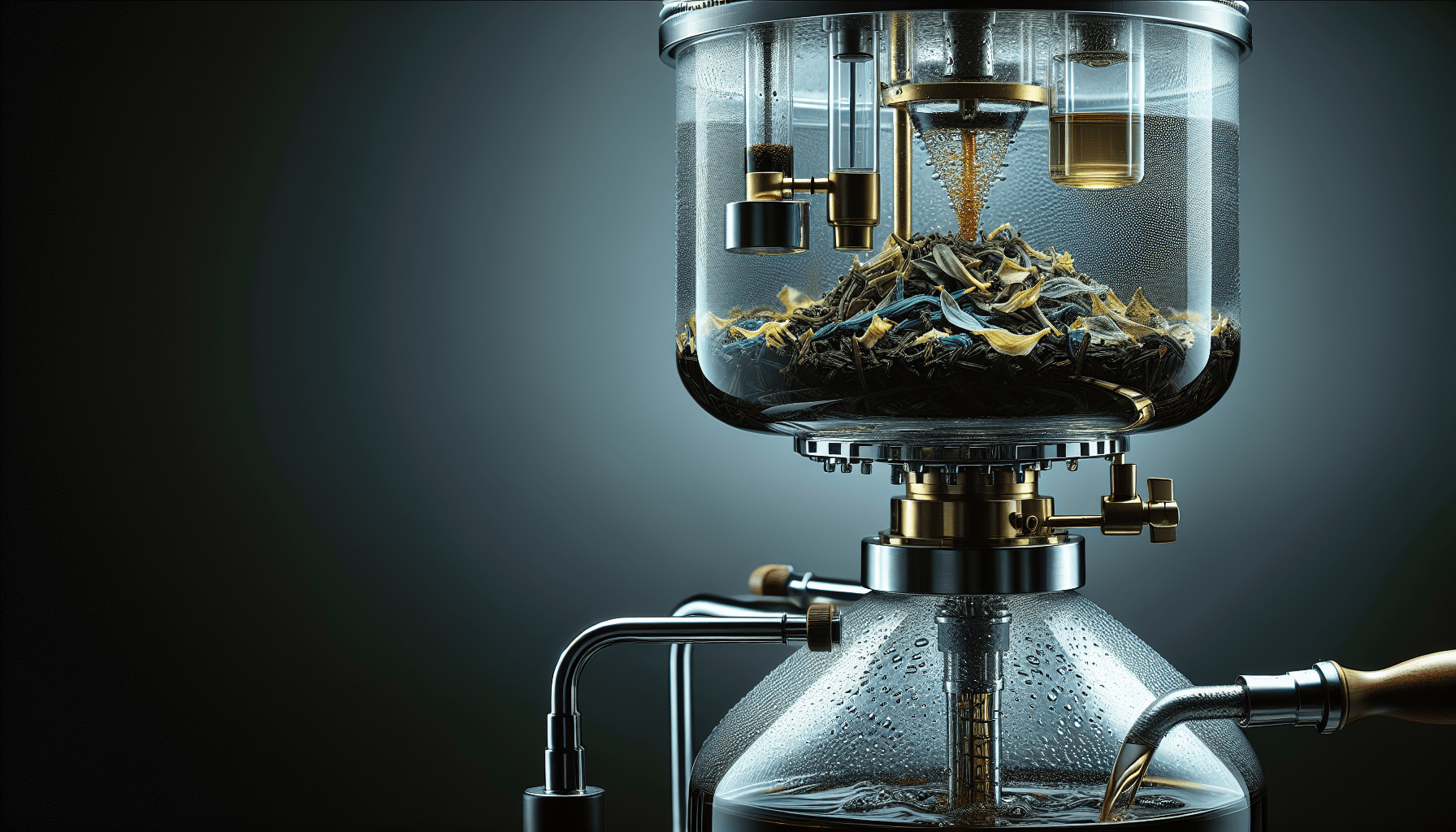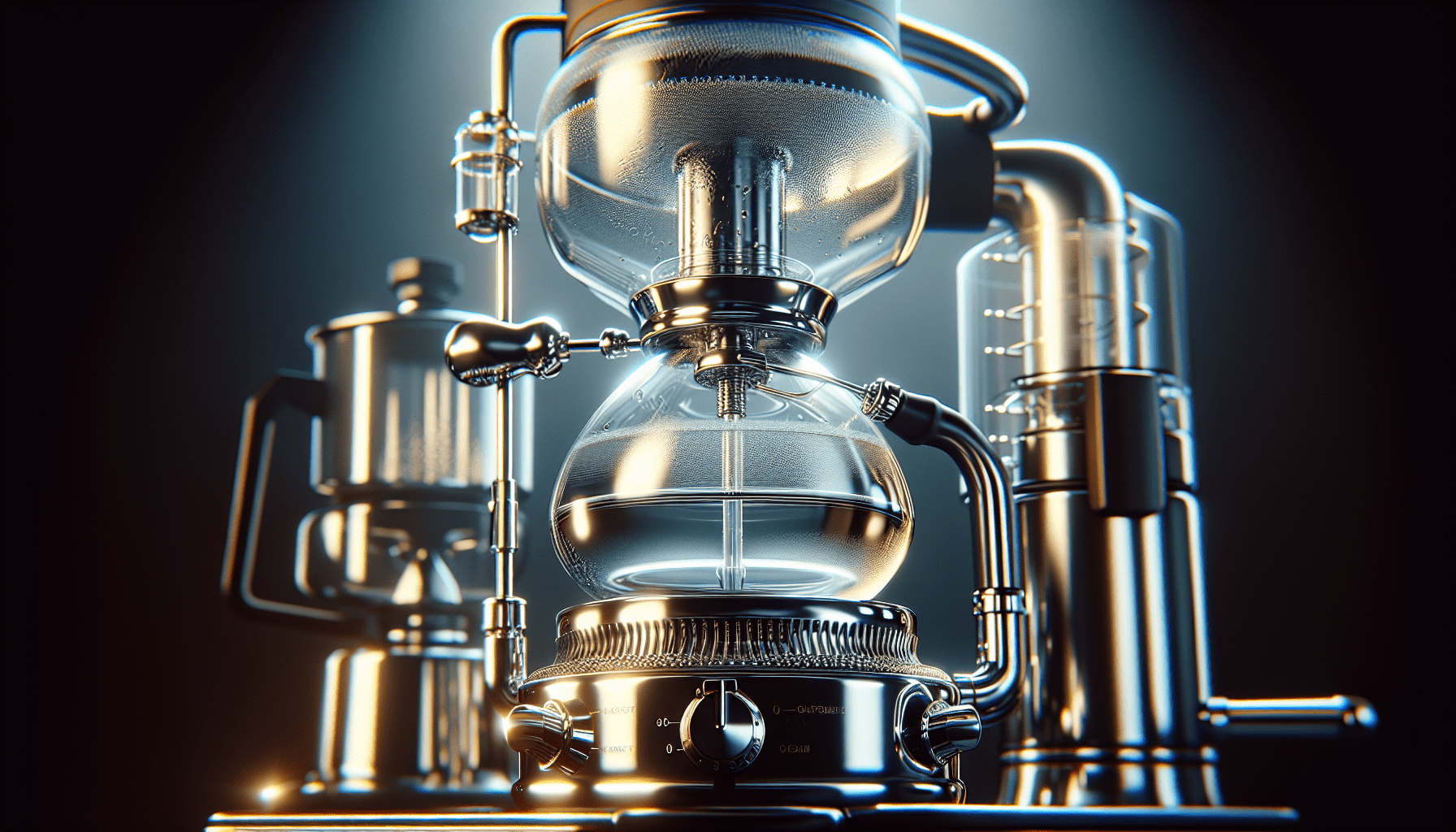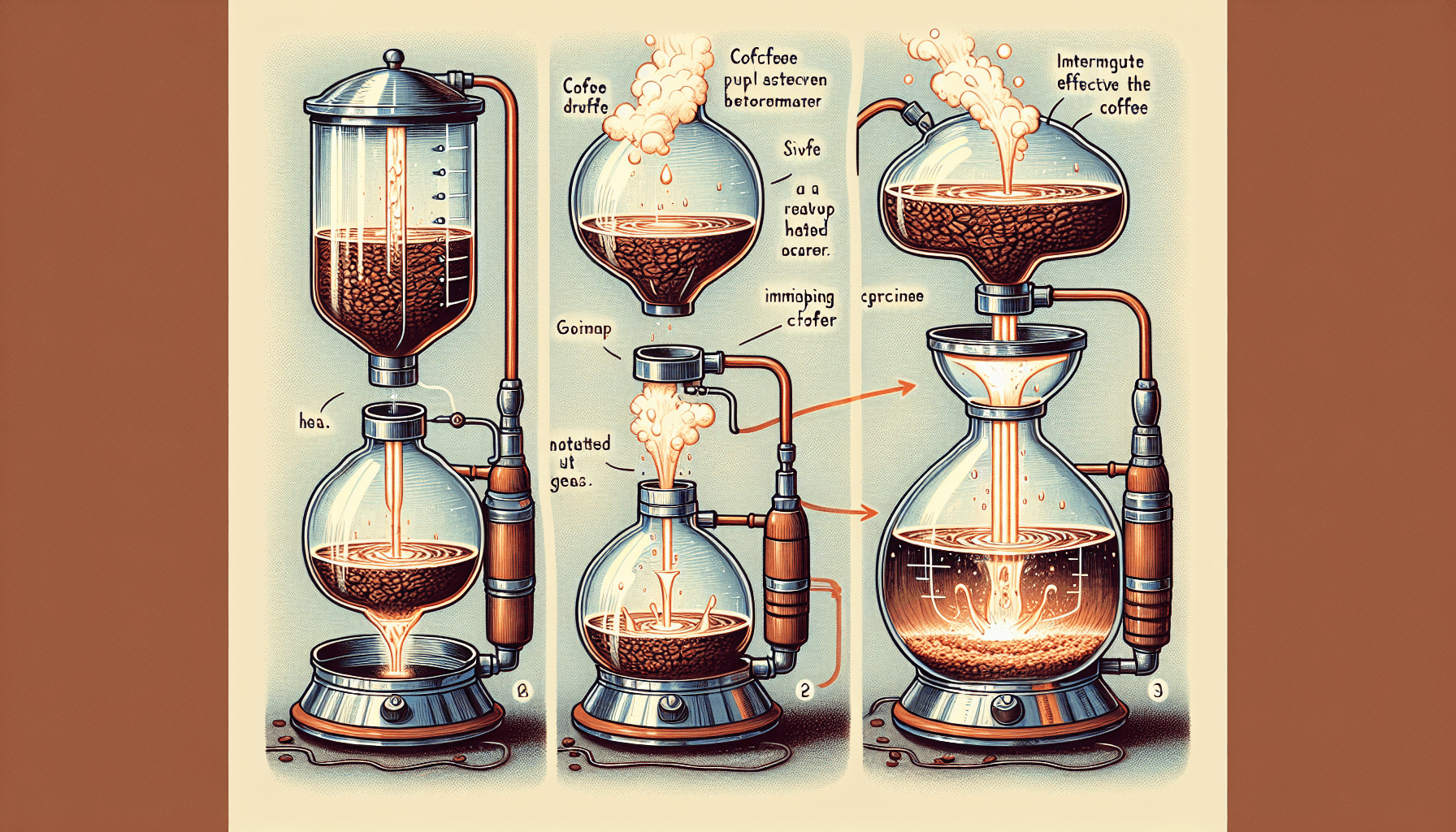Have you ever wondered if you could use a siphon coffee maker to brew a perfect cup of tea? Well, you’re in luck! In this article, we will explore the possibilities of making tea with a siphon coffee maker. Whether you’re a tea aficionado looking for a new brewing method or simply curious about experimenting with different gadgets in your kitchen, this article will provide all the information you need to know. So, grab your favorite tea leaves and let’s discover the fascinating world of tea brewing with a siphon coffee maker!
Introduction
Explanation of siphon coffee maker
A siphon coffee maker, also known as a vacuum coffee maker, is a unique and intriguing device that combines the beauty of scientific principles with the art of brewing coffee or tea. It consists of two chambers – one for water and one for the brewed beverage – connected by a tube and a filter. This apparatus creates a mesmerizing display as the water heats up, creating pressure that pushes it up into the top chamber where it mixes with the coffee or tea grounds. Once the temperature drops, a vacuum effect is created, pulling the brewed beverage back into the lower chamber, ready for enjoyment.
Tea-making process with siphon coffee maker
While siphon coffee makers are primarily used for brewing coffee, they can also be used to make exquisite tea. In this article, we will dive into the world of siphon coffee makers and explore how they can elevate your tea brewing experience. From understanding how they work to discussing the types of teas suitable for siphon brewing, we will guide you through the steps of preparing, brewing, and extracting the perfect cup of tea using this unique apparatus. So, get ready to uncover the secrets of siphon tea brewing!
Understanding Siphon Coffee Maker
Overview of siphon coffee maker
The siphon coffee maker is a versatile and elegant brewing device that combines the principles of pressure and vacuum to create a smooth and flavorful beverage. It is comprised of two main chambers – the bottom chamber, where water is heated and brewed, and the top chamber, where the coffee or tea is infused. The two chambers are connected by a tube and separated by a filter, which ensures that no coffee or tea grounds end up in your cup. The beauty of the siphon coffee maker lies in its ability to maintain a precise temperature throughout the brewing process, resulting in a clean and well-extracted cup of coffee or tea.
How does a siphon coffee maker work?
The magic of the siphon coffee maker lies in its reliance on heat and pressure differentials. When heat is applied to the bottom chamber, water vaporizes, creating pressure that forces the water up into the top chamber. Once the heat source is removed, the temperature drops, creating a vacuum that pulls the brewed coffee or tea back into the lower chamber. This cycle of pressure and vacuum creates a unique brewing environment that can extract the delicate flavors and aromas of tea leaves.
Components of a siphon coffee maker
A standard siphon coffee maker consists of various components that work together to create the perfect brew. The essential parts include:
-
Bottom Chamber: This is where the water is heated and brewed.
-
Top Chamber: This is where the brewed coffee or tea is infused and extracted.
-
Tube: The tube connects the two chambers, allowing the brewed beverage to flow back down.
-
Filter: The filter ensures that no coffee or tea grounds make it into your cup, providing a clean and smooth beverage.
-
Burner: The burner is responsible for providing heat to the bottom chamber. It can be fueled by gas or electricity.
Now that we have a basic understanding of how a siphon coffee maker works let’s explore the types of tea that are suitable for brewing with this fascinating device.
Types of Tea Suitable for Siphon Coffee Maker
Types of tea that can be brewed in a siphon coffee maker
Siphon coffee makers can be a wonderful tool to brew a variety of tea types, ranging from delicate and floral to robust and full-bodied. The following types of tea are particularly well-suited for the siphon brewing method:
-
Green Tea: Green teas, such as sencha or dragonwell, can benefit from the controlled temperature and infusion process of a siphon coffee maker. The gentle extraction allows the flavors and aromas of green tea to unfold gracefully.
-
Oolong Tea: Oolong teas, with their complex flavor profiles, are a perfect match for siphon brewing. The combination of heat and vacuum helps bring out the intricate nuances and fragrances of these teas.
-
Herbal Infusions: Siphon coffee makers can also be used to brew herbal infusions, such as chamomile or mint. The precise temperature control ensures that the delicate flavors and aromas of these herbs are captured and retained.
-
Black Tea: While black teas are traditionally steeped using boiling water, siphon brewing can provide a unique twist to their preparation. The controlled temperature and extraction process can result in a smooth and well-rounded cup of black tea.
Best flavors and characteristics for siphon brewing
When selecting teas for siphon brewing, it’s important to consider the flavors and characteristics that are enhanced by this brewing method. Teas with delicate and nuanced flavors, such as floral notes or subtle sweetness, can truly shine when brewed in a siphon coffee maker. Additionally, teas with complex flavor profiles, such as oolongs or black teas, can benefit from the controlled brewing process, as it allows the flavors to develop more harmoniously. Ultimately, it is a matter of personal preference, and the experimentation with different teas can lead to delightful discoveries.
Now that we have an idea of the teas that work well with a siphon coffee maker, let’s delve into the steps of preparing the apparatus for tea brewing.
Preparing the Siphon Coffee Maker for Tea
Cleaning the equipment
Before embarking on your tea brewing journey with a siphon coffee maker, it’s crucial to ensure that all parts of the apparatus are clean and free from any residual coffee or tea flavors. Start by disassembling the siphon coffee maker and rinsing each component thoroughly with warm water. Pay special attention to the filter and tubes, as they can harbor leftover remnants. If necessary, use a gentle brush or sponge to remove any stubborn residue. Once the parts are clean, allow them to air dry completely before reassembling the siphon coffee maker.
Choosing the appropriate filter
The filter plays a vital role in capturing any tea leaves or particles, preventing them from ending up in your cup. When selecting a filter for your siphon coffee maker, choose one that is specifically designed for loose-leaf tea. These filters are typically made of fine mesh and provide optimal filtration while allowing the full flavors of the tea to be extracted. Avoid filters that are too coarse or small, as they may either let through too many tea leaves or clog up during the brewing process.
Measuring and adding tea leaves
The amount of tea leaves needed for siphon brewing can vary depending on personal taste preferences and the type of tea being used. As a general guideline, start with approximately one teaspoon of loose-leaf tea per cup of water. Adjust the amount based on your preference for a stronger or milder brew. Place the measured tea leaves into the top chamber of the siphon coffee maker, ready to be infused with the hot water.
With the siphon coffee maker prepared for tea brewing, let’s move on to the crucial factors of water temperature and brew time.
Water Temperature and Brew Time
Ideal temperature for tea brewing
The temperature at which tea is brewed greatly impacts its flavor and aroma. While traditional brewing methods often call for specific water temperatures, the siphon coffee maker provides a unique opportunity to control the brewing temperature more precisely. As a general guideline, delicate teas, such as green or white teas, benefit from lower temperatures ranging from 160°F (71°C) to 180°F (82°C). Oolongs and black teas, on the other hand, can be brewed at slightly higher temperatures between 190°F (88°C) and 205°F (96°C). Adjusting the water temperature according to personal preference will allow you to unlock the full potential of your tea leaves.
Determining the appropriate brew time
The brew time for tea brewed in a siphon coffee maker can vary depending on the type of tea and personal taste preferences. As a starting point, aim for a brew time of around 3 to 4 minutes. This duration allows the tea leaves to fully infuse and release their flavors without becoming excessively bitter or astringent. However, do not hesitate to experiment with shorter or longer brew times to find the perfect balance that suits your palate.
Now that we have covered the crucial aspects of water temperature and brew time, let’s move on to the exciting process of brewing tea with a siphon coffee maker.
Brewing Tea with a Siphon Coffee Maker
Assembling the siphon coffee maker
Begin by assembling the siphon coffee maker, ensuring that all components fit snugly together. Make sure the filter is properly inserted and the tubes are securely connected between the two chambers. This will ensure optimal brewing conditions and prevent any leaks or mishaps during the brewing process.
Boiling the water
Fill the bottom chamber of the siphon coffee maker with fresh, cold water. The amount of water you add will depend on the desired quantity of tea you wish to brew. As a general guideline, aim for a water-to-tea ratio of approximately 8 fluid ounces (240 ml) per teaspoon of tea leaves. Place the siphon coffee maker on a heat source, such as a gas burner or electric stove, and apply gentle heat until the water reaches the desired temperature, as discussed earlier.
Adding the tea leaves
Once the water has reached the appropriate temperature, carefully add the measured tea leaves to the top chamber of the siphon coffee maker. Take care not to overflow the chamber and ensure that the tea leaves are evenly distributed to facilitate proper extraction.
Brewing and extracting the tea
As the water in the bottom chamber heats up, it will create pressure that pushes it up into the top chamber, where it blends with the tea leaves. Allow the tea to brew for the desired amount of time, carefully considering the recommendations for each specific tea type. During this time, the flavors and aromas of the tea will be extracted and infused into the water, resulting in a delightful cup of tea.
Filtering the brewed tea
Once the desired brew time has elapsed, remove the heat source from the bottom chamber. As the temperature drops, a vacuum effect will occur, pulling the brewed tea back into the lower chamber. This process separates the tea leaves from the liquid, ensuring a clean and pure cup of tea. To avoid any residual bitterness, carefully remove the top chamber before the vacuum effect is complete, preventing the tea from sitting on the grounds for too long.
With the tea brewed and separated from the grounds, it’s time to explore the advantages and disadvantages of using a siphon coffee maker for tea brewing.
Advantages and Disadvantages of Using a Siphon Coffee Maker for Tea
Pros of using a siphon coffee maker for tea brewing
-
Precise Temperature Control: The siphon coffee maker allows for precise control of the water temperature throughout the brewing process, ensuring optimal extraction and flavor development for different types of teas.
-
Spectacular Brewing Display: Brewing tea with a siphon coffee maker is not only a delicious experience but also a visually captivating one. The unique display of water movement and infusion adds an element of theater to the brewing process.
-
Clean and Smooth Extraction: The use of a filter in the siphon coffee maker ensures that no tea leaves or particles end up in your cup, resulting in a clean and smooth cup of tea.
-
Experimentation Opportunities: Siphon coffee makers provide ample opportunities for tea enthusiasts to experiment with different teas, tea blends, water temperatures, and brew times, allowing for a personalized and customized tea brewing experience.
Cons of using a siphon coffee maker for tea brewing
-
Equipment Complexity: Siphon coffee makers can be more complex to operate and clean compared to other brewing methods. The various components and delicate nature of the apparatus require careful handling and maintenance.
-
Time and Effort: Tea brewing with a siphon coffee maker may require more time and effort compared to simpler brewing methods. The assembly, heating, brewing, and cleaning processes can be more involved, making it less suitable for those looking for a quick cup of tea.
While the advantages of using a siphon coffee maker for tea brewing often outweigh the disadvantages, it’s important to consider your personal preferences and brewing style.
Alternative Use of Siphon Coffee Maker for Tea
Using siphon coffee maker for making iced tea
One delightful alternative use of a siphon coffee maker is for brewing iced tea. By adjusting the water temperature and brew time, you can create a concentrated tea infusion that can be poured over ice to create a refreshing and flavorful iced tea. Experiment with different tea blends and steeping techniques to find your perfect iced tea recipe.
Experimenting with various tea blends in siphon maker
Siphon coffee makers provide a unique platform for exploring the world of tea blends. Whether it’s combining different types of teas, infusing herbs and spices, or adding floral accents, the controlled brewing environment of a siphon coffee maker allows you to unleash your creativity and create custom tea blends. This experimentation can lead to exciting and unexpected flavor combinations, offering a truly one-of-a-kind tea experience.
With a sense of adventure and a willingness to try new things, the possibilities for brewing tea with a siphon coffee maker are endless.
Tips and Tricks for Brewing Tea with Siphon Coffee Maker
Choosing the right tea leaves and blends
When selecting tea leaves for siphon brewing, opt for high-quality loose-leaf teas. Whole tea leaves provide a better flavor extraction and a more enjoyable tea drinking experience compared to tea bags. Additionally, consider experimenting with different tea blends or adding complementary ingredients, such as dried fruits or spices, to create unique and personalized tea flavors.
Maintaining proper water temperature
Consistency in water temperature is crucial for successful tea brewing with a siphon coffee maker. Use a thermometer or temperature-controlled kettle to ensure accuracy. Alternatively, you can experiment with preheating the water to specific temperatures before adding it to the siphon coffee maker.
Experimenting with brew times and steeping techniques
Remember that the recommended brew times for tea are only a starting point. Through trial and error, you can discover your preferred brew times that suit your taste preferences. Additionally, you can experiment with different steeping techniques, such as multiple infusions or adjusting the strength of the tea by using different amounts of tea leaves.
By playing around with these variables, you can find your own perfect combination for brewing tea with a siphon coffee maker.
Conclusion
In conclusion, a siphon coffee maker offers a unique and captivating way to brew tea. By understanding the principles behind the device, selecting the appropriate tea types, and following the proper brewing techniques, you can create a truly memorable and flavorful cup of tea. Although the process may require a bit more time and effort compared to other brewing methods, the results are well worth it. So, ignite your curiosity, embark on a tea-brewing adventure with a siphon coffee maker, and prepare to unlock the true potential of your tea leaves. Cheers to a delightful and satisfying tea experience!




